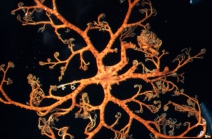Traits taxon details
Euryale Lamarck, 1816
123585 (urn:lsid:marinespecies.org:taxname:123585)
accepted
Genus
- Species Euryale aspera Lamarck, 1816
- Species Euryale purpurea Mortensen, 1934
marine, fresh, terrestrial
Lamarck, J.-B. de. (1816). Ordre Second. Radiaires Échinodermes. <em>Histoire naturelle des animaux sans vertèbres.</em> 2, 522-568., available online at https://www.biodiversitylibrary.org/page/13299296 [details]
Stöhr, S.; O’Hara, T.; Thuy, B. (Eds) (2021). World Ophiuroidea Database. Euryale Lamarck, 1816. Accessed through: Marine Species Traits editorial board (2021) Marine Species Traits at: https://www.marinespecies.org/traits/aphia.php?p=taxdetails&id=123585 on 2025-04-03
Marine Species Traits editorial board (2025). Marine Species Traits. Euryale Lamarck, 1816. Accessed at: https://www.marinespecies.org/traits/aphia.php?p=taxdetails&id=123585 on 2025-04-03
Date
action
by
original description
Lamarck, J.-B. de. (1816). Ordre Second. Radiaires Échinodermes. <em>Histoire naturelle des animaux sans vertèbres.</em> 2, 522-568., available online at https://www.biodiversitylibrary.org/page/13299296 [details]
taxonomy source Okanishi, M.; O'Hara, T. D.; Fujita, T. (2011). Molecular phylogeny of the order Euryalida (Echinodermata: Ophiuroidea), based on mitochondrial and nuclear ribosomal genes. <em>Molecular Phylogenetics and Evolution.</em> 61: 392-399. [details]
basis of record Hansson, H.G. (2001). Echinodermata, <B><I>in</I></B>: Costello, M.J. <i>et al.</i> (Ed.) (2001). <i>European register of marine species: a check-list of the marine species in Europe and a bibliography of guides to their identification. Collection Patrimoines Naturels,</i>. 50: pp. 336-351. (look up in IMIS) [details]
additional source Rowe, F. W. E.; Gates, J. (1995). Echinodermata. <em>In: Wells, A.; Houston, W.W.K. (Ed.) Zoological catalogue of Australia, 33. CSIRO: Melbourne. ISBN 0-643-05696-3. XIII.</em> 510 pp. [details]
source of synonymy Neave, Sheffield Airey. (1939-1996). Nomenclator Zoologicus vol. 1-10 Online. <em>[Online Nomenclator Zoologicus at Checklistbank. Ubio link has gone].</em> , available online at https://www.checklistbank.org/dataset/126539/about [details]
status source Stöhr, S. (2011). New records and new species of Ophiuroidea (Echinodermata) from Lifou, Loyalty Islands, New Caledonia. <em>Zootaxa.</em> 3089: 1-50., available online at http://www.mapress.com/zootaxa/2011/f/zt03089p050.pdf [details]
taxonomy source Okanishi, M.; O'Hara, T. D.; Fujita, T. (2011). Molecular phylogeny of the order Euryalida (Echinodermata: Ophiuroidea), based on mitochondrial and nuclear ribosomal genes. <em>Molecular Phylogenetics and Evolution.</em> 61: 392-399. [details]
basis of record Hansson, H.G. (2001). Echinodermata, <B><I>in</I></B>: Costello, M.J. <i>et al.</i> (Ed.) (2001). <i>European register of marine species: a check-list of the marine species in Europe and a bibliography of guides to their identification. Collection Patrimoines Naturels,</i>. 50: pp. 336-351. (look up in IMIS) [details]
additional source Rowe, F. W. E.; Gates, J. (1995). Echinodermata. <em>In: Wells, A.; Houston, W.W.K. (Ed.) Zoological catalogue of Australia, 33. CSIRO: Melbourne. ISBN 0-643-05696-3. XIII.</em> 510 pp. [details]
source of synonymy Neave, Sheffield Airey. (1939-1996). Nomenclator Zoologicus vol. 1-10 Online. <em>[Online Nomenclator Zoologicus at Checklistbank. Ubio link has gone].</em> , available online at https://www.checklistbank.org/dataset/126539/about [details]
status source Stöhr, S. (2011). New records and new species of Ophiuroidea (Echinodermata) from Lifou, Loyalty Islands, New Caledonia. <em>Zootaxa.</em> 3089: 1-50., available online at http://www.mapress.com/zootaxa/2011/f/zt03089p050.pdf [details]
 Present
Present  Inaccurate
Inaccurate  Introduced: alien
Introduced: alien  Containing type locality
Containing type locality

